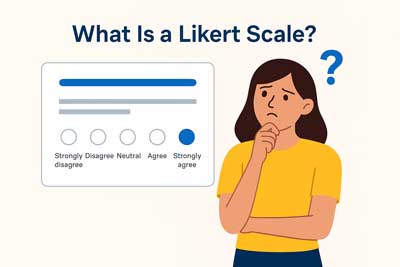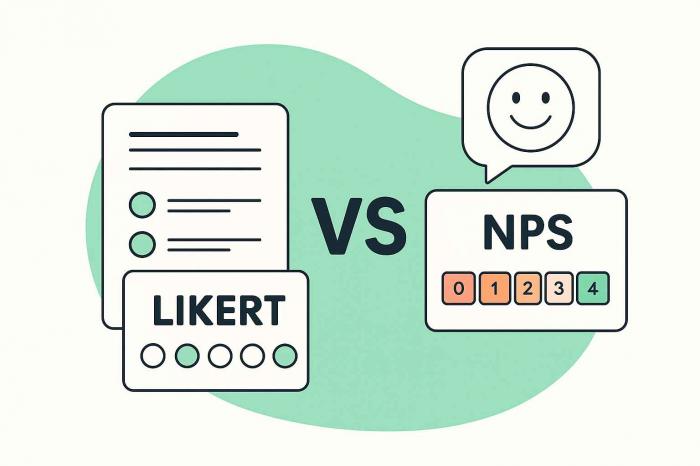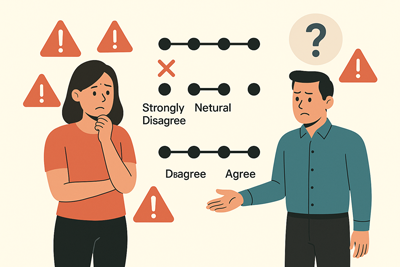What Is a Likert Scale and How Does It Work?
 When you fill out a survey that asks how strongly you agree or disagree with a statement, you are interacting with a Likert scale — one of the most common and trusted methods for measuring opinions, attitudes, and satisfaction. Developed in 1932 by psychologist Rensis Likert, this scale provides a structured way to transform subjective human emotions into quantifiable, comparable data.
When you fill out a survey that asks how strongly you agree or disagree with a statement, you are interacting with a Likert scale — one of the most common and trusted methods for measuring opinions, attitudes, and satisfaction. Developed in 1932 by psychologist Rensis Likert, this scale provides a structured way to transform subjective human emotions into quantifiable, comparable data.
Over the decades, the Likert scale has become an indispensable tool in employee engagement research, customer feedback analysis, market studies, and academic surveys. It allows researchers and organizations to move beyond simple yes-or-no responses and capture the degree of feeling behind a respondent’s opinion.
Understanding What a Likert Scale Is
A Likert scale measures attitudes or perceptions through a series of statements. Each statement asks respondents to express their level of agreement or disagreement using a fixed range of responses — typically from Strongly Agree to Strongly Disagree. For example:
“I am satisfied with the customer service I received.”
Strongly Agree
Agree
Neutral
Disagree
Strongly Disagree
Each option is assigned a numeric value (for instance, 5 for “Strongly Agree” and 1 for “Strongly Disagree”). This numeric scoring makes it possible to analyze trends, averages, and satisfaction levels. A Likert scale therefore converts qualitative attitudes into quantitative insights, bridging the gap between emotion and data.
If you’d like to understand how the number of response points impacts your data, our guide 5-Point vs 7-Point Likert Scale, explores the subtle differences between both formats.
How the Likert Scale Works in Practice
At its core, the Likert method relies on structured statements rather than questions. Each statement is designed to reflect an aspect of a respondent’s belief or experience. When someone selects their response, they are essentially ranking the intensity of their attitude toward that statement.
The responses are not random — they form what researchers call ordinal data. This means the answers can be ordered (for example, “Agree” is higher than “Neutral”), but the distance between them is not numerically exact. Despite this limitation, the scale is still powerful because it gives a standardized way to compare feelings across individuals or groups.
In a customer feedback context, for instance, you might ask ten satisfaction statements rated on a 5-point Likert scale. Each score can then be averaged to create an overall satisfaction index or analyzed individually to identify which service area needs improvement.
When designing such surveys, it’s important to maintain balance. Each statement should be neutral in tone — not leading respondents toward a particular answer.
The Purpose and Power of the Likert Scale
The main purpose of the Likert scale is to measure intensity of opinion rather than simple agreement. It captures nuance — allowing respondents to say not just what they feel, but how strongly they feel it. This depth is invaluable when measuring concepts such as job satisfaction, brand perception, or service quality.
In an employee engagement survey, for example, a Likert question might be:
“I have access to the tools I need to perform my work effectively.”
When analyzed collectively, the average response shows how empowered employees feel. Similarly, in customer satisfaction research, statements such as “The product met my expectations” or “The support team was responsive” provide measurable insight into consumer attitudes.
This flexibility is why the Likert scale has become the backbone of modern survey design — a subject we explore further in Why the Likert Scale Is the Backbone of Modern Surveys.
The Common Types: 5-Point and 7-Point Scales
There are several variations of the Likert scale, but the 5-point and 7-point models are the most frequently used.
The 5-Point Likert Scale
This is the classic format that most people recognize. It includes five response options ranging from Strongly Disagree to Strongly Agree. It’s straightforward, quick to answer, and easy to analyze, making it suitable for short surveys or general satisfaction assessments. The 5-point Likert scale strikes a balance between precision and simplicity — respondents rarely feel overwhelmed, and results are easy to interpret statistically.
The 7-Point Likert Scale
The 7-point Likert scale adds two intermediate levels of intensity — for instance, Slightly Agree and Slightly Disagree. This extended scale allows for more nuanced data and helps distinguish subtle differences in sentiment. Researchers often choose it for in-depth market or academic studies where small variations in opinion matter.
If you’re unsure which to select, our guide How Many Points Should a Likert Scale Have? examines when a broader scale adds value and when it can lead to unnecessary complexity.
Why the Likert Scale Works So Well
What makes the Likert scale unique is its ability to standardize subjective experiences. It transforms emotional perceptions into a consistent format that can be tracked over time, compared between departments, or analyzed across demographics.
Because the same statements and scales can be reused, researchers can measure changes year after year — for example, comparing employee satisfaction in 2023 versus 2025. This comparability makes the Likert scale far more reliable than open-ended questions, which are harder to quantify.
It also facilitates advanced analysis methods, such as factor analysis and correlation studies, by providing structured numerical data. To explore how Likert responses can be turned into statistical insight, see How to Analyze Likert Scale Data Like a Pro.
Advantages and Limitations
The advantages of the Likert scale are numerous. It is easy to understand, adaptable across industries, and provides actionable data for improving customer and employee experiences. The uniform format enables cross-question comparisons and trend monitoring, while the consistent labeling (like “Strongly Agree” to “Strongly Disagree”) enhances respondent reliability.
However, it’s important to be aware of the limitations. Respondents sometimes choose the middle (neutral) option to avoid taking a stance, a behavior known as central tendency bias. Others may habitually agree with statements — a phenomenon called acquiescence bias. These biases can slightly distort results if not accounted for.
To avoid these pitfalls, ensure your statements are neutrally phrased and balanced in tone. We’ve detailed more on this topic in Common Mistakes When Using the Likert Scale, which offers practical advice for maintaining survey validity.
How Likert Scale Data Is Analyzed
Analyzing Likert data involves converting each response into numerical values, then summarizing them through averages, medians, or distribution charts. For instance, if a question about product usability averages 4.6 on a 5-point scale, it indicates a strong positive sentiment.
Researchers often use visualization techniques such as stacked bar charts to represent results, making it easier to communicate findings.
Whether you’re analyzing data manually or through platforms like Excel, SPSS, or Power BI, the core principles remain the same: treat the data consistently and look for patterns rather than individual responses.
A detailed walkthrough of these methods can be found in How to Analyze Likert Scale Data Like a Pro, where we show exactly how to clean, code, and interpret Likert responses accurately.
When to Use a Likert Scale
The Likert scale should be used when you want to understand how much someone agrees, disagrees, or feels about a statement — not just a yes/no response. It’s ideal for gauging perceptions, satisfaction, motivation, or confidence levels.
For example, in an education survey, you might ask:
“I feel confident using digital learning tools.”
In a marketing study, you might include:
“The brand communicates its values clearly.”
Each generates insight that can guide decision-making and strategic improvement.
For measuring overall loyalty or referral likelihood instead, tools like NPS (Net Promoter Score) might be more appropriate — which we cover in Likert Scale vs NPS: When to Use Each Method.
Final thoughts
The Likert scale remains one of the most effective ways to measure subjective attitudes in an objective, data-driven manner. Its simplicity, versatility, and scientific reliability make it the standard in modern survey design.
When used thoughtfully — with well-phrased statements, consistent response options, and careful analysis — the Likert scale transforms raw opinions into meaningful insights. It enables businesses to improve experiences, educators to measure engagement, and researchers to validate hypotheses with precision.
To continue your understanding, read our next article, 5-Point vs 7-Point Likert Scale: Which One Should You Use?, where we compare both formats and help you choose the best one for your research.

